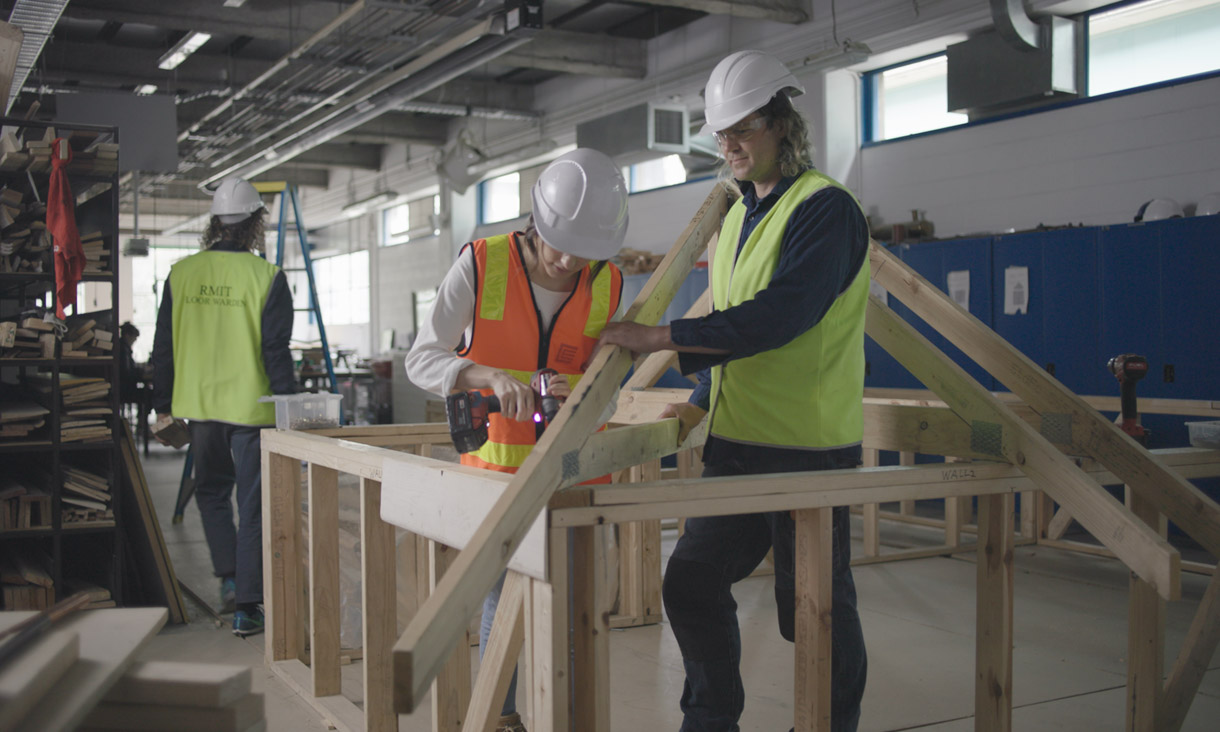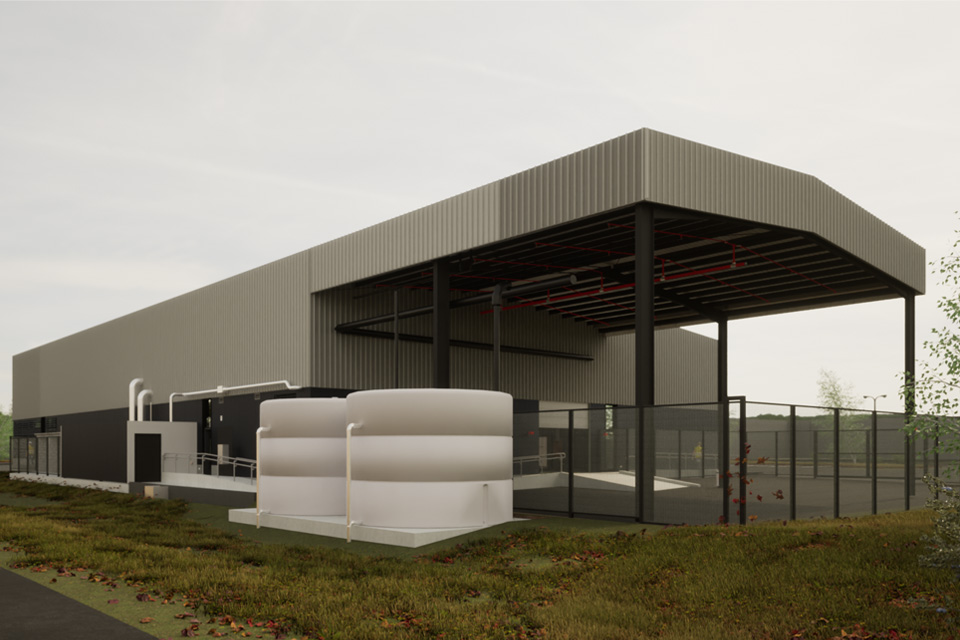Building and Construction Foundation Scholarship
For project and construction management and building and construction students passionate about a career in the industry; worth $5,000.
Construction is not just about building sites, but about building a bigger picture: the planning, coordination, and control of a project from inception to delivery.
In this diploma, you'll examine the principles, techniques and regulations of the building and construction industry for all types of medium-rise and wide-span buildings up to 25 metres high.
This practical curriculum incorporates hands-on work and project-based learning. You'll experience many aspects of building projects and understand how they all relate to each other. You’ll go on site excursions to gain hands-on field experience which will include visits to residential and commercial construction projects.
Assignments are designed with real or simulated industry conditions and include site visits, field exercises, and workshops.
Choose from day or evening classes to work around your work or life commitments.
Graduates have the option to continue further studies in construction, project management, or property services with RMIT.

Studying the Diploma of Building and Construction has helped Danielle open doors to exciting job prospects in the building industry.
*Students require a Construction Induction Card (CPCCWHS1001A Prepare to Work Safely in the Construction Industry) to take part in required site visits and or/associated assessment.
*This is a Free TAFE priority course. Check your eligibility.
This training is delivered with Victorian and Commonwealth Government funding.

RMIT’s Trades Innovation Centre is a cutting-edge facility offering the latest in skills training and technology for students and industry.
The 1,700 square metre modular design features adaptable spaces, including a 2.5-metre-deep sand pit, double-height workshop ceilings, and a three-storey training rig that mimics building construction for real-world experience.
Divided into ‘trade zones’, this allows students to gain hands-on experience while observing other trades, fostering a deeper understanding of how different trades intersect and work together.
This diploma emphasises project-based learning.
Your assessment will be based on real or simulated industry conditions, and your studies will include site visits, field exercises, and workshops.
Some practical components may be delivered at the Bundoora campus.
The types of classes you have will depend on the course you’re studying. Classes are offered in various formats designed to provide meaningful engagement with staff, industry and peers and provide for access and use of spaces where learning can be applied and active, including an array of specialised equipment.
Most RMIT courses do not include passive large-scale classes such as lectures, instead the content traditionally provided in lectures is made available online. This may be in the form of readings, videos or other on-demand learning materials. This content will also support the basis of interactive learning that takes place in on-campus classes.
The world is constantly changing, and there are universal skills that can help you adapt to the evolving nature of work and global engagement.
As part of your study experience at RMIT, we provide 6 future-focused RMIT Capabilities:
RMIT Capabilities are built into your course as well as some of our extracurricular experiences. They inform the design and delivery of your learning activities and assessments, so by the time you graduate, you’ll be ready to apply these capabilities in your life and work.
This diploma has been developed in response to industry needs, and it is recognised by building and construction industry organisations.
RMIT offers three modes of delivery for this diploma:
Students are able to mix day and evening subjects according to personal circumstances and class availability.
Studying this diploma full time should take approximately two years. Enrolling in fewer classes will result in a longer study duration of up to six years.
The knowledge and skills you will acquire throughout this qualification and how they can be applied in your career are described in the learning outcomes.
You'll learn all aspects of the building industry, including:
Choose a plan below to find out more about the subjects you will study and the course structure.
Graduates of this diploma can explore career paths in:
You may also find employment in other related fields, either on a building site or in a head office environment.
Jobs and Skills Australia projects that work opportunities for architectural, building and surveying technicians are set to increase by 4.1% to 2028.
You need to satisfy all of the following academic (entry) requirements to be considered for entry into this course.
Successful completion of the Victorian Certificate of Education (VCE) (or equivalent)
OR
Successful completion of post-secondary studies (Certificate II or higher) in a related field (e.g. building, construction, plumbing etc);
OR
At least 6 months’ work experience in a related field (e.g. building, construction, plumbing etc).
If you are applying for a guaranteed packaged pathway option, please note that they are available at both the City and Bundoora Campus. If you are interested in attending Bundoora, you can apply to the City offering either via VTAC or Direct and transfer prior to enrolling.
Please note: Students required to hold a Construction Industry White Card (CPCCWHS1001A Prepare to Work Safely in the Construction Industry) in order to take part in mandatory site visits and or/associated assessments.
There are no prerequisite subjects required for entry into this qualification.
A selection task is not required for entry into this qualification.

Undertaking a certificate, diploma, advanced diploma or associate degree can help you meet the entry requirements for your preferred degree. These qualifications often provide credit, reducing the duration of your bachelor degree.
This course offers pathway options. If you don’t meet the entry requirements, a formal pathway might be your way in.
Guaranteed Pathways gives you the option to preference pathway packages in VTAC.
If you apply and are successful in gaining a place in a Guaranteed Pathway package, you will progress straight into the Bachelor Degree upon successful completion of the relevant vocational degree (otherwise known as TAFE) first.
With a Guaranteed Pathway package, you can graduate with two internationally-recognised RMIT qualifications.
Credit, recognition of prior learning, professional experience and accreditation from a professional body can reduce the duration of your study by acknowledging your earlier, relevant experience.
Credit and exemptions will be assessed consistent with the principles of the RMIT Credit Policy.
Successful completion of the Diploma of Building and Construction (Building) will provide Guaranteed entry into the following programs:
The Victorian Government is currently waiving tuition fees for this program for students who meet eligibility requirements for government subsidised places.
Visit Free TAFE for priority courses for further information on what this means and whether you may be eligible.
If you have any questions you can contact Study@RMIT.
The tuition fees below will apply if you are not receiving a Free TAFE fee waiver.
The tuition fees you will pay for this program will depend on whether you are offered a Victorian Government subsidised place or a full-fee place. To find out if you are eligible for a government subsidised place, follow the steps at How to check if you are eligible.
*Fees shown are indicative only and subject to change given individual circumstances at the time of enrolment.
Use our fee finder to get an estimate of your fees for this program.
The student tuition fees as displayed by the fee finder are indicative only and subject to change given individual circumstances at enrolment. Fees are adjusted on an annual basis and these fees should only be used as a guide.
The Australian Government provides financial assistance via the VET Student Loans scheme, which allows eligible students in eligible programs to defer payment of their tuition fees, up to the maximum loan amount for their program.
For information on how to pay your fees or how to apply for a refund, please see Paying your fees and applying for refunds.
In addition to tuition fees, you will be charged an annual student services and amenities fee (SSAF), which is used to maintain and enhance services and amenities that improve your experience as an RMIT student.
The SSAF is calculated based on your enrolment load and the maximum fee for 2025 is $365.
You may also be required to purchase other items related to this course, including field trips, textbooks and equipment.
While we make every effort to ensure that materials fees are kept to a minimum and are competitive with alternative suppliers, material fees are not compulsory and you may choose to purchase these items independently.
For more information about material and other fees for this course, see additional fees and expenses.
The Australian Government provides financial assistance via the VET Student Loans scheme, which allows eligible students in eligible programs to defer payment of their tuition fees, up to the maximum loan amount for their program.
If your VET Student Loan application is successful, the Australian Government will pay RMIT your tuition fees on your behalf, up to the maximum loan amount for your program.
Your VET Student Loan becomes part of your VETSL debt. You will start repaying your accumulated VETSL debt to the Australian Government once you earn above the minimum income threshold for repayment, which is adjusted each year (this also applies if you are still studying).
The Australian Taxation Office (ATO) will calculate your compulsory repayment for the year and include this on your income tax notice.
The Royal Melbourne Institute of Technology advises that:
For more information see VET Student Loans or Study Assist.
If your program is eligible for the VET Student Loan scheme and has a loan cap that doesn’t cover the total amount of the tuition fees for your program, then you’ll need to pay RMIT the difference by the due date once you exceed the cap.
It’s easy for you to keep track of your VET Student Loan debt, and you can choose to make upfront payments at any time before the census date.
For project and construction management and building and construction students passionate about a career in the industry; worth $5,000.
RMIT awards more than 2000 scholarships every year to recognise academic achievement and assist students from a variety of backgrounds.
Use our Frequently Asked Questions to learn about the application process and its equity access schemes, find out how to accept or defer your offer or request a leave of absence, discover information about your fees, refunds and scholarships, and explore the various student support and advocacy services, as well as how to find out more about your preferred program, and more.
Acknowledgement of Country
RMIT University acknowledges the people of the Woi wurrung and Boon wurrung language groups of the eastern Kulin Nation on whose unceded lands we conduct the business of the University. RMIT University respectfully acknowledges their Ancestors and Elders, past and present. RMIT also acknowledges the Traditional Custodians and their Ancestors of the lands and waters across Australia where we conduct our business - Artwork 'Sentient' by Hollie Johnson, Gunaikurnai and Monero Ngarigo.
Welcome to RMIT - Study@RMIT
Live chat hours
For after hours assistance, submit your enquiry and we'll get back to you as soon as possible.